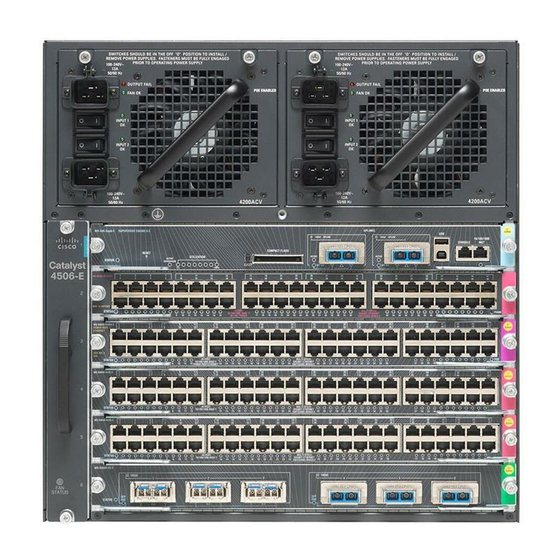
Cisco WS-C4507R Manuals
Manuals and User Guides for Cisco WS-C4507R. We have 3 Cisco WS-C4507R manuals available for free PDF download: Configuration Manual, Command Reference Manual, Troubleshooting Manual
Cisco WS-C4507R Configuration Manual (612 pages)
Catalyst 4500 Series Switches
Table of Contents
-
-
-
-
-
-
-
-
LACP Modes90
-
-
-
-
-
-
Blocking State103
-
Listening State103
-
Learning State104
-
Forwarding State105
-
-
-
PVST+ Mode108
-
Rapid PVST108
-
MISTP Mode108
-
MISTP-PVST+ Mode109
-
-
Using PVST118
-
Using Rapid PVST124
-
Configuring MST142
-
-
CHAPTER 8 Configuring Spanning Tree Portfast, BPDU Guard, BPDU Filter, Uplinkfast, Backbonefast, and
157-
Configuring VTP177
-
-
-
VLAN Ranges209
-
-
-
-
Configuring VMPS256
-
VMPS Example264
-
-
Configuring Qos
277 -
-
-
Disabling Qos283
-
-
Configuring CGMP288
-
Enabling CGMP288
-
Disabling CGMP292
-
Configuring GMRP293
-
Disabling GMRP299
-
-
-
Using Telnet340
-
Using Ping343
-
-
-
-
SNMP Terminology369
-
SNMP Terminology370
-
-
SNMP Entity379
-
-
-
-
SPAN Session391
-
Destination Port392
-
Source Port392
-
Reflector Port393
-
Ingress SPAN393
-
Egress SPAN393
-
-
Vspan
393-
Configuring SPAN394
-
SPAN Traffic394
-
-
-
-
-
-
Advertisement
Cisco WS-C4507R Command Reference Manual (578 pages)
Command Reference
Brand: Cisco
|
Category: Network Router
|
Size: 1.39 MB
Table of Contents
-
Getting Help21
-
Action38
-
Apply39
-
Auto-Sync45
-
Class-Map50
-
Clear Pagp69
-
Clear Qos71
-
Debug Backup75
-
Debug Dot1X80
-
Debug Ipc84
-
Debug Lacp88
-
Debug Nvram90
-
Debug Pagp91
-
Debug Pm94
-
Debug Sw-Vlan103
-
Debug Udld107
-
Debug Vqpc108
-
Deny110
-
Dot1X Guest-Vlan113
-
Dot1X Initialize114
-
Dot1X Max-Req116
-
Dot1X Timeout123
-
Duplex125
-
Flowcontrol132
-
Hw-Module Power135
-
Instance136
-
Interface Range140
-
Interface Vlan142
-
Related Commands151
-
Ip Dhcp Snooping156
-
Ip Igmp Filter165
-
Ip Igmp Profile167
-
Ip Igmp Snooping169
-
Ip Mfib Fastdrop180
-
Ip Sticky-Arp184
-
Main-Cpu212
-
Match213
-
Monitor Session214
-
Mtu218
-
Name219
-
Permit222
-
Policy-Map224
-
Power DC Input228
-
Power Inline229
-
Private-Vlan235
-
Qos Cos247
-
Qos Dbl248
-
Qos Dscp250
-
Qos Map Cos251
-
Qos Map Dscp252
-
Qos Trust256
-
Qos Vlan-Based258
-
Redundancy259
-
Remote-Span263
-
Reset265
-
Revision266
-
Service-Policy267
-
Session Module268
-
Shape269
-
Show Auto Qos273
-
Show Bootflash275
-
Show Bootvar277
-
Show Class-Map278
-
Show Dot1X287
-
Show Environment290
-
Show Flowcontrol299
-
Show Idprom301
-
Show Interfaces306
-
Show Ip Cef Vlan331
-
Show Ip Mfib348
-
Show Ip Mroute351
-
Show Ipc359
-
Show Lacp364
-
Show Module384
-
Show Monitor386
-
Show Pagp388
-
Show Policy-Map390
-
Show Power395
-
Show Qos399
-
Show Qos Dbl401
-
Show Qos Maps403
-
Show Redundancy405
-
Show Slaveslot0412
-
Show Slot0414
-
Show System Mtu425
-
Show Udld428
-
Show Vlan429
-
Show Vlan Mtu436
-
Show Vmps440
-
Show Vtp441
Cisco WS-C4507R Troubleshooting Manual (66 pages)
Troubleshooting Guide
Brand: Cisco
|
Category: Network Router
|
Size: 0.88 MB
Table of Contents
-
CPU Queues16
-
Port States25
-
Root Guard29
-
Rapid Pvst29
-
Port Numbers42
-
Mac Acls43
Advertisement


